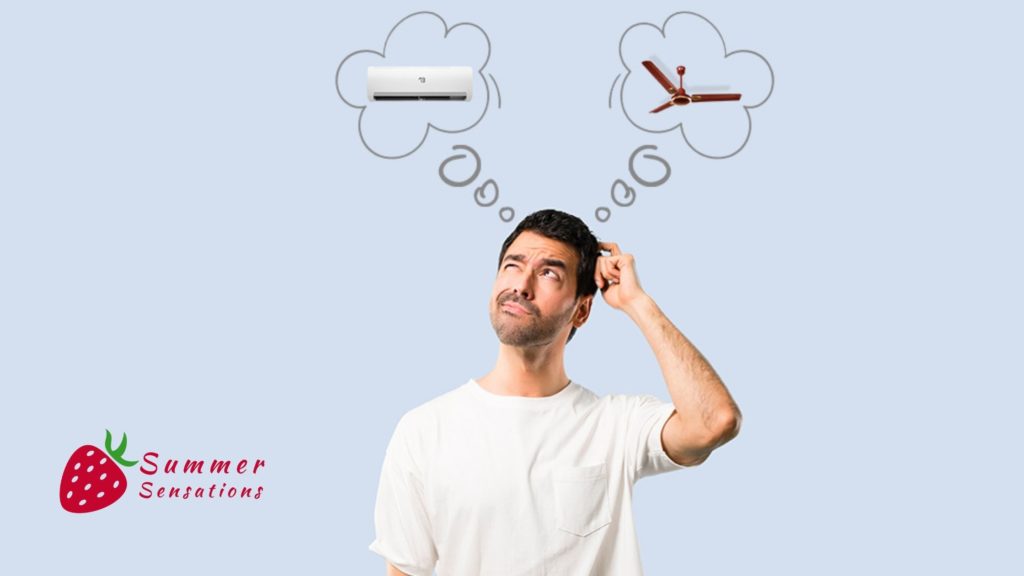
It’s the age-old debate dividing families and causing drama. No, we’re not talking about controlling the TV remote, but ceiling fan installation vs air conditioning which is best? Money-conscious homeowners ponder the question every summer as the mercury exceeds 30°C across Australia. Is the extra cost of air conditioning worth the comfort, or are ceiling fans adequate?
Unfortunately, there’s no universal approach to this. On the bright side, however, a bit of research should guide you in the right direction as to which is the better choice for your family and your budget. Who knows, you might even strike a winning balance between both ceiling fans and air conditioners. Let us go over the pros and cons of both, and find out which works best in your house.
Fan vs AC Case & Cost
The major factor for everyone is the fan vs. AC cost. Some questions that keep arising how much does a fan cost? What is the cost to run a fan all day? Is running an air conditioner expensive?
The cost of running a fan vs air conditioner in a mild yet humid city like Sydney, ceiling fan installation is preferred is something that comprises a lot of variables. It includes initial cost, operating and maintenance cost. So let’s have a look:
1. The Case & Cost For Air Conditioners
- From the old window-rattler kind to a ducted unit, to a portable one, to a modern split system one, and to the more exotic evaporative kinds, modern air conditioners have been in our lives for around 100 years. Once installed, air conditioners are a great way to keep cool while sinking back a beer on a Sunday afternoon watching test cricket.
- During a heatwave, you will probably notice hermit-like behaviour on your behalf, coming out of your chilled room only for snacks, drinks, and toilet breaks. It doesn’t have to be like this though. While this scene is common for window and split system air conditioner users – where effectively only one room is chilled – ducted air conditioners can cool a whole house, and some have ‘zoning’ capabilities where you can make one room cooler than the other. This works especially well for apartment buildings, and chances are in an apartment you already have ducted air conditioning. For the maximum chill factor, you simply cannot beat an air conditioner on a scorching summer’s day.
- The main drawback with air conditioning is the cost. The costs of the unit price, installation, and power usage. As broken down in this article, you can expect the humble split system air conditioner to cost around 33c-40c an hour. Say you run it eight hours a day, you could expect that unit to cost nearly $100 in power alone! Installation by a licensed technician, maintenance costs, and unit costs also add up here.
- Ducted is yet more extreme, running anywhere from $1.48 to $1.94 an hour. Though ducted systems are most commonly found in apartments, and apartments are usually part of an embedded electricity network to get a better deal on power. Being that split systems can run anywhere from $500-$2,000+ in price, and ducted systems into the tens of thousands, you might find you blow your cool over the cost. With air conditioning, you’ll have to weigh up whether the cost to benefit ratio is worth it.
2. The Case & Cost For Ceiling Fans
- The humble ceiling fan where would we be without it? Sweating profusely, probably. Ceiling fans are a staple in many Australian homes, and for good reason. Their fuss-free operations that whisk hot air up and cool air down are beloved by Aussies in summer, and fans are such a staple that many people don’t pay any attention to them. A common sight in the north of Australia is to have airy, open houses with more fans than you can poke a stick at operating at all hours of the day.
- Though, there are fairly prominent shortfalls of using ceiling fans. The most obvious is that they don’t cool the environment; they just push cool air around, which can eventually wick your sweat away. It’s no surprise that when you enter a fanned room, you don’t feel the chilled presence like with an air conditioner.
- Another shortfall of the ceiling is the obvious risk of blades swirling above your head. If your roof is rather short, then stretching your hands above your head can be a perilous task. Getting your fingers whacked in a fan isn’t a great feeling. Furthermore, some fans are just downright noisy! Some fans on their maximum level feel like your whole house is about to take off! Air cons on the other hand usually hum away in a dull monotone or with no noise at all. The main drawbacks of ceiling fans are pretty stated; is that enough to make you not a fan of ceiling fans?
- On the plus side, the main benefit of ceiling fans is their supremely low cost to run. They can cost as little as 2c per hour to run, which makes them an obvious choice from a cost perspective. This allows you to run them for longer, and at less cost than an air conditioner. A ceiling fan can cost 20 times less to run than a split system air conditioner but is the sacrifice of a completely chilled room or house worth it.
Pros & Cons Using Fans vs AC
If you’re still confuddled, we’re starting to see electricians using social media such as TikTok for marketing then taking a quick look at the benefits and drawbacks of each cooling method can be particularly helpful.
Ceiling Fans Pros
- Cheaper to run than air conditioning
- Uses only about 65 watts per hour
- Doesn’t require maintenance, and is unlikely to break or malfunction
- Efficient in more open spaces
- Doesn’t dry out the air
Ceiling Fans Cons
- Don’t actually cool space, rather push air around the room, which then indirectly cools your body
- You basically need to stand directly under a fan to feel its full benefit
- Limited temperature control
- Generally doesn’t have the power to reach every corner of the room
Air Conditioners Pros
- Very effective at cooling spaces
- Actually cools a space rather than indirectly cooling your body
- The effects of AC are felt much quicker
- Can be set to maintain a specific temperature
- Reverse cycle units can also keep you warm in winter
Air Conditioners Cons
- More expensive option in terms of running cost
- Can use as much as 2,200 watts per hour
- Require regular maintenance in order to keep the filters clean and functioning
- Can break, and will most likely be expensive to fix
- Can dry out the air being conditioned, which can have adverse health effects
- Inefficient in open spaces
Conclusion
A more efficient way to simultaneously achieve energy-saving and cooling is to use both air conditioners and fan together. Because of the cooling effect of the fan, you can set your AC at a temperature a few degrees higher than usual. Instead of the typical 74 degrees, you can have your AC at 78 degrees and still feel comfortable. For each degree raised on the AC thermostat, there is a 1% reduction in energy used. By increasing the temperature to 78 degrees from 74 degrees, the energy bill can come down from $400 per month to $384 per month. This is the ideal way you can get the best of both worlds!
